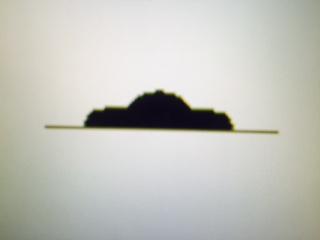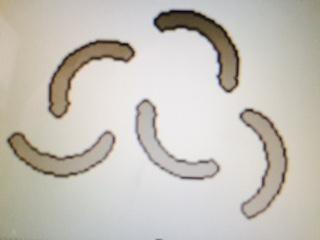Instructions for Side by Side Printing
- Print the notecards
- Fold each page in half along the solid vertical line
- Cut out the notecards by cutting along each horizontal dotted line
- Optional: Glue, tape or staple the ends of each notecard together
Micro lab questions
front 1 Which one of the following statements about bacteria in the environment is false? A. A
single gram of garden soil may contain a billion bacterial
cells. | back 1 B. There are no bacteria found on clean, healthy human skin. |
front 2 When Staphylococcus epidermidis is incubated on a Petri dish of Phenolethanol agar, individual cells grow into visible colonies. But when Esherichia coli is plated on this medium, it dies. In this respect phenolethanol agar is an example of: A. a
general purpose medium | back 2 C. a selective medium |
front 3 Many Gram negative bacteria can grow on MacConkey agar but the growth of most Gram positive bacteria is inhibited. What ingredient is used in MacConkey agar to cause this inhibition? A. agar
| back 3 C. bile salts |
front 4  When describing a bacterial colony growing on an agar plate, the elevation of the colony is one of the traits that can be noted. What is the term used to describe a colony that has this sort of elevation profile?
| back 4 E. umbonate |
front 5 Agar is:
| back 5 A. a polymer extracted from algae that has no nutritional value |
front 6 What substance(s) in sucrose fermentation broth can act as a carbon source?
| back 6 D. There are two carbon sources in sucrose fermentation broth, sucrose and amino acids. |
front 7 Which one of the following statements best describes the appearance of a reliable positive result for a carbohydrate fermentation test.
| back 7 C. The medium is cloudy and yellow. |
front 8 The type of microscopy we use to examine bacteria that are stained by the Gram stain procedure is called:
| back 8 A. bright-field microscopy. |
front 9 You are looking at an insect with a compound microscope. The ocular lens has a magnification of 8X and the objective lens has a magnification of 2X. What is the total magnification?
| back 9 E. 16X |
front 10 What is the diameter a typical coccus bacterium?
| back 10 B. 1 x 10-6 meters |
front 11 Which of the following statements about using amino acids in media for the culturing of bacteria is true?
| back 11 D. All of the above (A – C) are true. |
front 12  What would be the term used to describe the shape of these bacteria?
| back 12 D. vibrio |
front 13 Which one of the following statements about the Gram stain is false?
| back 13 C. In the Gram stain, alcohol is used to kill the bacteria. |
front 14 The Gram stain divides microorganisms into two groups, purple vs. red, on the basis of differences in the:
| back 14 C. thickness of the peptidoglycan layer of the cell wall. |
front 15 What is the correct order in which these reagents are used in the Gram stain?
| back 15 C. Crystal Violet, Iodine, Ethanol, Safranin |
front 16 You grow a pure culture of an unknown bacteria on a starch agar plate. After 48 hours you flood the plate with iodine. Most of the plate turns dark blue except for a clear zone around the bacterial growth. What does this mean?
| back 16 A. The bacteria excrete amylase. |
front 17 You streak an unknown bacterium on a blood agar plate. After incubation you notice a distinct zone around the colonies that is completely clear. What does this mean?
| back 17 D. The bacteria are beta-hemolytic. |
front 18 All of the following statements describe Escherichia coli
except one. Which one of the following statements is
false? | back 18 A. Escherichia coli is a Gram positive coccus. |
front 19 A mutant strain of bacteria that has an additional nutritional requirement that is not seen in the wildtype strain is called:
| back 19 D. an auxotroph |
front 20 Which one of the following statements about the O-F glucose test is true?
| back 20 E. Enteric bacteria like Escherichia coli cause both tubes to turn yellow. |
front 21 Used to determine if a bacterium can grow by using fermentative metabolism:
| back 21 A. O-F glucose tube |
front 22 Used to detect the production of extracellular amylase enzyme:
| back 22 B. starch agar |
front 23 Used to detect the production of extracellular lipase enzyme:
| back 23 E. egg yolk agar |
front 24 Used to see if a bacterial strain can make acid from table sugar when growing anaerobically:
| back 24 D. sucrose fermentation broth |
front 25 Used to detect the hydrolysis of gelatin:
| back 25 B. ammonium sulfate |
front 26 Used to keep oxygen out of broth or semisolid media:
| back 26 C. sterile mineral oil |
front 27 Used as a source of vitamins, amino acids and other nutrients in rich complex media:
| back 27 E. yeast extract |
front 28 Used to detect starch hydrolysis in the amylase test:
| back 28 D. iodine |
front 29 Appearance of a positive Amylase Test:
| back 29 A. a clear zone is seen around the bacterial growth after addition of a chemical reagent |
front 30 In the appearance of a positive test, the bacteria make acid because they ferment a sugar.
| back 30 D. the medium turns yellow |
front 31 Appearance of a positive Hemolysis Test:
| back 31 B. a clear zone is seen around the bacterial growth after incubation |
front 32 Appearance of a positive Lipase Test:
| back 32 B. a clear zone is seen around the bacterial growth after incubation |
front 33 In the appearance of a positive Test, the bacteria grow on Simmon’s citrate agar:
| back 33 C. the medium turns blue |
front 34 Clean the slide and place a small drop of water on the slide.
| back 34 A. the first step |
front 35 Allow the slide to dry at room temperature.
| back 35 C. the third step |
front 36 Use a sterile inoculating loop to spread a tiny sample of bacteria on the slide.
| back 36 B. the second step |
front 37 Quickly pass the slide through the flame to heat fix the cells to the glass.
| back 37 D. the fourth step |
front 38 When you label a Petri dish culture, you should always write the information on the lid of the plate. | back 38 False |
front 39 Gram negative bacteria that ferment lactose form pale white colonies on EMB agar. | back 39 False |
front 40 At a pH of 7.0, the indicator dye bromthymol blue is green. | back 40 True |
front 41 Luria agar is a defined medium that contains only glucose and inorganic salts. | back 41 False |
front 42 In the gelatinase test, the plate is flooded with ammonium sulfate after incubation. | back 42 True |
front 43 Iodine forms a blue-black complex when it binds to lipids found in egg yolk. | back 43 False |
front 44 There are no vitamins or amino acids in Simmon’s citrate agar. | back 44 True |
front 45 When you put a Petri dish into an incubator you should always put the agar side up. | back 45 True |
front 46 Used as a mordant for the flagella stain:
| back 46 C. tannic acid |
front 47 Used to stain endospores:
| back 47 B. malachite green (with heat for 5 minutes) |
front 48 Used as a counterstain:
| back 48 D. safranin |
front 49 Used to stain the background in the capsule stain:
| back 49 A. congo red |
front 50 Which of the following bacterial species can make heat resistant endospores and be grown in aerobic conditions?
| back 50 B. Bacillus cereus |
front 51 Which of the following bacterial species makes a capsule which is an important virulence factor?
| back 51 E. all of the above |